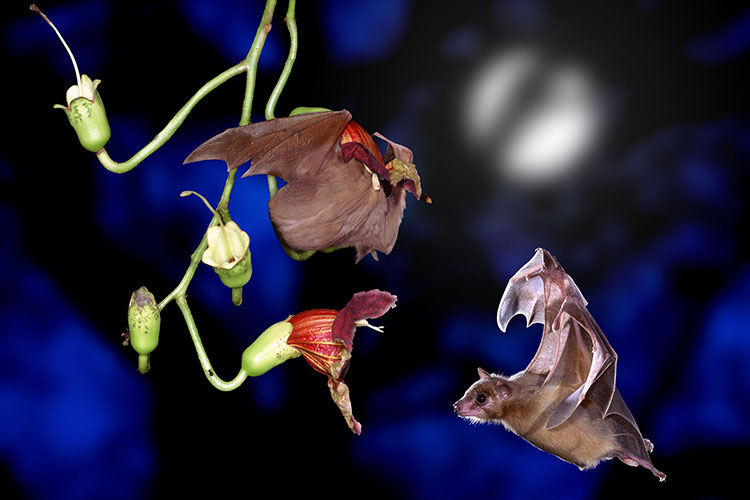Bats’ brains sync when they socialize
Study sheds light on how brains process social interactions

June 20, 2019

Socializing bats show highly correlated brain activity, shows a new UC Berkeley study. (Kim Taylor/Warren Photographic photo)
The phrase “we’re on the same wavelength” may be more than just a friendly saying: A new study by University of California, Berkeley, researchers shows that bats’ brain activity is literally in sync when bats engage in social behaviors like grooming, fighting or sniffing each other.
“Whenever the bats were socially interacting, you could see these very robust correlations in brain activity,” said Michael Yartsev, an assistant professor of neurobiology and bioengineering at UC Berkeley.
This study, appearing June 20 in the journal Cell, is the first to observe synchronized brain activity in a non-human species engaging in natural social interactions. The finding opens the door to future study on how our brains process social interactions and has potential implications for understanding diseases, like autism, that affect social behavior.
“This is a very core phenomenon that, for two decades, people have been excited about in humans,” Yartsev said. “Now that we’ve observed it in an animal model, it opens the door to very detailed research of it.”
While some correlations have been found between brain activity in socializing humans, human studies have been limited to using brain imaging techniques, such as functional magnetic resonance imaging (fMRI), which does not measure electrical activity directly, or electroencephalography (EEG), which is typically limited to measuring low frequency brain waves.
In the study, Yartsev and Berkeley postdoctoral scholar Wujie Zhang used wireless neural recording devices to measure bats’ brain activity while the bats freely interacted in a chamber. The researchers’ recording devices allowed them to capture what fMRI and EEG techniques cannot — signals that include the bats’ higher frequency brain waves, as well as electrical activity from individual neurons.
They found surprisingly strong correlations between the bats’ brains, especially for brain waves in the high frequency band. These correlations were present whenever the bats shared a social environment and increased before and during their social interactions.
“The inter-brain correlations were so strong that you could easily see them in the raw data,” Zhang said. “This is the first time in my career where a result was so robust that it popped out from the data like that.”

The researchers used wireless neural recording devices to track the brain activity of freely behaving bats, and uncovered a surprising degree of correlation when the bats were engaged in social behaviors like grooming, fighting or sniffing each other. (Kim Taylor/Warren Photographic photo)
To better understand these correlations, a team of undergraduate assistants went frame-by-frame through hours of high-speed video of the bats, characterizing their behavior in each frame. Zhang and Yartsev then analyzed the relationship between bat behavior and inter-brain correlation.
Their detailed analysis allowed them to rule out other possible explanations for the synced-up brain activity, such as that the bats’ brains were simply reacting to the same environment, or that the bats were engaging in the same behavior. For example, two bats placed in identical, but separate, chambers and both busy grooming did not show the same synchronization.
The inter-brain synchronization was really all about sharing a social experience together, Yartsev said. Even when three bats shared the same social environment, but only two of them were actively interacting with each other, the brains of all three were synchronized.
“It’s kind of like, if you think about a dinner table, some people could be talking back and forth, while another person would be sitting there, still paying attention, while still being part of the social interaction,” Yartsev said. “Under that analogy, then, supposedly all of the brains would be correlated simultaneously.”
There is still much to be revealed about just what this high frequency band of brain waves does, though there is some evidence that it is involved in a number of mental processes that would be needed to successfully navigate a dinner party — including sensory and emotional information-processing, attention and working memory.
And while being “on the same wavelength” may seem a little magical or mysterious, the researchers stress that it is anything but.
“One of the explanations of this is that, when you and I are interacting, we are basically forming a closed loop,” Yartsev said. “I am doing a bunch of motor actions, such as articulating words, and you are hearing them, and you are processing them, and then you are making ongoing, on-the-fly decisions about how to react to them. And I respond in exactly the same way to you. This loop between us is what likely leads to brains getting linked to one another and is an important aspect of the ability to engage in successful social interactions.”
“The ‘magic’ here is social interaction,” Zhang added. “When we interact, our brains engage each other indirectly through our behaviors.”
This research was supported by the National Institutes of Health (DP2-DC016163), the New York Stem Cell Foundation NYSCF-R-NI40, the Alfred P. Sloan Foundation (FG-2017-9646), the Brain Research Foundation (BRFSG-2017-09), the National Science Foundation (NSF- 1550818), the Packard Fellowship (2017-66825), the Klingenstein-Simons Fellowship, the Pew Charitable Trust (00029645) and the Dana Foundation.